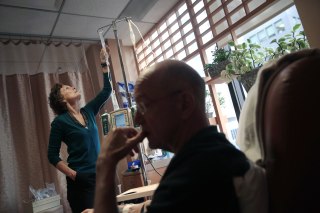Spending on cancer treatments has spiked past the $100 billion mark globally over the past five years, with almost half that amount in the United States alone, according to a report released Thursday.
The extra money is mostly going to pricey new targeted drugs that are adding years to some patients’ lives and transforming the way certain cancers are treated, the report from the independent QuintilesIMS Institute finds.

Quintiles found that worldwide spending on cancer drugs and supportive medications — such as anti-nausea drugs and blood boosters — grew from $91 billion in 2012 to $113 billion in 2016. Patients in the U.S. accounted for 46 percent of that spending.
The report predicts annual growth of between 6 percent and 9 percent through 2021.
Extremely expensive targeted immunotherapy drugs have driven changes in both spending and cancer care, the report finds.
Related: Half of U.S. Cancer Deaths Due to Bad Habits
“During the past decade, advances in personalized medicine and immuno-oncology have fueled a major shift in treatment of cancer,” the report reads.
Traditional cancer treatments have always included surgery and still do, but old-fashioned chemotherapy was a blunt weapon aimed at any fast-growing cell. Chemo has improved but the targeted therapies can help select groups of patients even more, with fewer side-effects.
“Since 2011, the cancer treatment landscape has been transformed by new medicines which target 22 different types of cancers,” the report reads.
These include drugs such as Keytruda, which takes a new approach to treating cancer by stopping tumor cells from cloaking themselves against the immune system response that normally takes out cancerous cells. Keytruda — known generically as pembrolizumab — targets the activity of genes called PD-1 (anti-programmed-death-receptor-1) and PD-L1.
Keytruda costs about $12,500 a month, or $150,000 a year. It’s been approved for a growing list of tumor types and earlier this month became the first cancer drug ever approved by the U.S. Food and Drug Administration to be used on any solid tumor, based on its genetic profile. Other drugs with similar actions include Tecentriq, known generically as atezolizumab.
Drug companies are encouraged by the effectiveness of these drugs, quicker approval times and the price tags, too.
Related: Cancer Deaths Have Fallen 25 Percent
The FDA and other regulators have approved 68 new cancer drugs since 2011 and 631 potential new drugs are in development, Quintiles found.
The median approval time from a company getting a patent on a drug to final FDA OK has dropped from 10.25 years in 2013 to 9.8 years in 2016, the report also found.
One type of cancer that’s benefited from research advances is melanoma, the report noted.
Melanoma is a big killer. More than 76,000 Americans will be diagnosed with melanoma this year and more than 10,000 will die from it, up from 8,500 in 2009, according to the American Cancer Society.
Not only are there the new PD-1 immune therapy treatments, but there are drugs targeting other genetic mutations, including BRAF inhibitors, MEK inhibitors and anti-CTLA4 drugs that have tripled the number of melanoma patients who get treatment.
“Until the relatively recent launch of these innovations, there was virtually no effective therapeutic option for melanoma patients,” the report noted.
“The concept of personalized medicine is now an integral part of clinical practice in oncology, and more clinical trials are stratifying patient populations with predictive biomarkers; this has led to improved clinical outcomes by stratifying patients for their response to treatment,” the report said.
